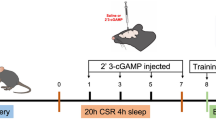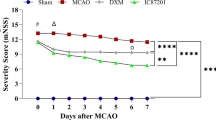Abstract
Objectives
Chronic neuroinflammation has become one of the important causes of common neurodegeneration disease. Therefore, the target of this study was to explore the protective action of glabridin on lipopolysaccharide (LPS)-induced neuroinflammation in vivo and in vitro and its mechanism.
Methods
The neuroinflammation model was established by LPS-induced BV2 cells. The cell viability with various concentrations of glabridin was determined by MTT assay, and the content of NO in each group was detected. A neuroinflammatory model was established in male C57BL/6J mice for a water maze test. Subsequently, NF-κB and SOD indices were measured by ELISA, GFAP and IBA-1 indices were measured by immunofluorescence, and Nissl staining was used to explore the Nissl bodies in the hippocampus of mice.
Results
In vitro experiments, our results expressed that glabridin could markedly increase the cell activity of LPS-induced BV2 cells and reduce the NO expression in cells. It indicated that glabridin had a remarkable impact on the neuroinflammation of LPS-induced BV2 cell protection. In vivo neuroinflammation experiments, mice treated with different doses of glabridin showed significantly improved ability of memory compared with the LPS group in the Morris water maze test. The levels of NF-κB, GFAP, and the number of positive cells in Nissl staining were decreased. High-dose glabridin significantly increased the SOD content in the brain tissue and decreased the IBA-1 levels.
Conclusion
Glabridin can significantly reduce or even reverse LPS-induced neuroinflammation, which may be related to the fact that glabridin can reduce the NO expression, NF-κB, IBA-1, GFAP, and other inflammatory mediators, upregulate the expression of SOD to relieve oxidative stress of brain and inhibit the activation of gliocyte in brain tissue.






Similar content being viewed by others
Abbreviations
- LPS:
-
Lipopolysaccharide
- MTT:
-
Methyl-thiazolyl-tetrazolium
- NO:
-
Nitric oxide
- NF-κB:
-
Nuclear factor kappa-B
- SOD:
-
Superoxide dismutase
- ELISA:
-
Enzyme-linked immunosorbent assay
- TTP488:
-
Azeliragon
- GFAP:
-
Glial fibrillary acidic protein
- IBA-1:
-
Ionized calcium-binding adapter molecule 1
- DG:
-
Dentate gyrus
- CA1:
-
Glutamine 1
- CY3:
-
Cyanine3
- FITC:
-
Fluorescein Isothiocyanate
References
Bindu S, Mazumder S, Bandyopadhyay U (2020) Non-steroidal anti-inflammatory drugs (NSAIDs) and organ damage: a current perspective. Biochem Pharmacol 180:114147
Bluthé R-M, Castanon N, Pousset F, Bristow A, Ball C, Lestage J, Dantzer R (1999) Central injection of IL-10 antagonizes the behavioural effects of lipopolysaccharide in rats. Psychoneuroendocrinology 24(3):301–311
Carro E, Bartolome F, Bermejo-Pareja F, Villarejo-Galende A, Molina JA, Ortiz P, Orive G (2017) Early diagnosis of mild cognitive impairment and Alzheimer’s disease based on salivary lactoferrin. Alzheimers Dement (amst) 8:131–138. https://doi.org/10.1016/j.dadm.2017.04.002
Cui YM, Ao MZ, Li W, Yu LJ (2008) Effect of glabridin from Glycyrrhiza glabra on learning and memory in mice. Planta Med 74(4):377–380. https://doi.org/10.1055/s-2008-1034319
Dinel AL, Lucas C, Guillemet D, Laye S, Pallet V, Joffre C (2020) Chronic supplementation with a mix of Salvia officinalis and Salvia lavandulaefolia improves Morris water maze learning in normal adult C57Bl/6J mice. Nutrients 12(6):1777. https://doi.org/10.3390/nu12061777
El-Saber Batiha G, Magdy Beshbishy A, El-Mleeh A, Abdel-Daim MM, Prasad Devkota H (2020) Traditional uses, bioactive chemical constituents, and pharmacological and toxicological activities of Glycyrrhiza glabra L. (Fabaceae). Biomolecules 10(3):352. https://doi.org/10.3390/biom10030352
Fotakis G, Timbrell JA (2006) In vitro cytotoxicity assays: comparison of LDH, neutral red, MTT and protein assay in hepatoma cell lines following exposure to cadmium chloride. Toxicol Lett 160(2):171–177. https://doi.org/10.1016/j.toxlet.2005.07.001
Giovannoni F, Quintana FJ (2020) The role of astrocytes in CNS inflammation. Trends Immunol 41(9):805–819. https://doi.org/10.1016/j.it.2020.07.007
Griciuc A, Serrano-Pozo A, Parrado AR, Lesinski AN, Asselin CN, Mullin K, Tanzil RE (2013) Alzheimer’s disease risk gene CD33 inhibits microglial uptake of amyloid beta. Neuron 78(4):631–643. https://doi.org/10.1016/j.neuron.2013.04.014
Kang JS, Yoon YD, Cho IJ, Han MH, Lee CW, Park S-K, Kim HM (2005) Glabridin, an isoflavan from licorice root, inhibits inducible nitric-oxide synthase expression and improves survival of mice in experimental model of septic shock. J Pharmacol Exp Ther 312(3):1187–1194
Karthikkeyan G, Pervaje R, Pervaje SK, Prasad TSK, Modi PK (2021) Prevention of MEK-ERK-1/2 hyper-activation underlines the neuroprotective effect of Glycyrrhiza glabra L. (Yashtimadhu) against rotenone-induced cellular and molecular aberrations. J Ethnopharmacol 274:114025. https://doi.org/10.1016/j.jep.2021.114025
Kim JY, Kang JS, Kim HM, Ryu HS, Kim HS, Lee HK, Han S-B (2010) Inhibition of bone marrow-derived dendritic cell maturation by glabridin. Int Immunopharmacol 10(10):1185–1193
Kwon HS, Koh SH (2020) Neuroinflammation in neurodegenerative disorders: the roles of microglia and astrocytes. Transl Neurodegener 9(1):42. https://doi.org/10.1186/s40035-020-00221-2
Kwon HS, Oh SM, Kim JK (2008) Glabridin, a functional compound of liquorice, attenuates colonic inflammation in mice with dextran sulphate sodium-induced colitis. Clin Exp Immunol 151(1):165–173. https://doi.org/10.1111/j.1365-2249.2007.03539.x
Lafrenaye AD, Mondello S, Wang KK, Yang Z, Povlishock JT, Gorse K, Kochanek PM (2020) Circulating GFAP and Iba-1 levels are associated with pathophysiological sequelae in the thalamus in a pig model of mild TBI. Sci Rep 10(1):13369. https://doi.org/10.1038/s41598-020-70266-w
Leng F, Edison P (2021) Neuroinflammation and microglial activation in Alzheimer disease: where do we go from here? Nat Rev Neurol 17(3):157–172. https://doi.org/10.1038/s41582-020-00435-y
Li C, Eom T, Jeong Y (2015) Glycyrrhiza glabra L. extract inhibits LPS-induced inflammation in RAW macrophages. J Nutr Sci Vitaminol (tokyo) 61(5):375–381. https://doi.org/10.3177/jnsv.61.375
Li G, Nikolic D, van Breemen RB (2016) Identification and chemical standardization of Licorice raw materials and dietary supplements using UHPLC-MS/MS. J Agric Food Chem 64(42):8062–8070. https://doi.org/10.1021/acs.jafc.6b02954
Liu K, Pi F, Zhang H, Ji J, Xia S, Cui F, Sun X (2017) Metabolomics analysis to evaluate the anti-inflammatory effects of polyphenols: Glabridin reversed metabolism change caused by LPS in RAW 264.7 cells. J Agric Food Chem 65(29):6070–6079. https://doi.org/10.1021/acs.jafc.7b01692
Liu Y, Zhang Y, Zheng X, Fang T, Yang X, Luo X, Yu Y (2018) Galantamine improves cognition, hippocampal inflammation, and synaptic plasticity impairments induced by lipopolysaccharide in mice. J Neuroinflammation 15(1):112. https://doi.org/10.1186/s12974-018-1141-5
Markina YV, Kirichenko TV, Markin AM, Yudina IY, Starodubova AV, Sobenin IA, Orekhov AN (2022) Atheroprotective effects of glycyrrhiza glabra L. Molecules 27(15):4697. https://doi.org/10.3390/molecules27154697
McKenna M, McDougall JJ (2020) Cannabinoid control of neurogenic inflammation. Br J Pharmacol 177(19):4386–4399. https://doi.org/10.1111/bph.15208
Nam HY, Nam JH, Yoon G, Lee JY, Nam Y, Kang HJ, Hoe HS (2018) Ibrutinib suppresses LPS-induced neuroinflammatory responses in BV2 microglial cells and wild-type mice. J Neuroinflammation 15(1):271. https://doi.org/10.1186/s12974-018-1308-0
Norden DM, Trojanowski PJ, Villanueva E, Navarro E, Godbout JP (2016) Sequential activation of microglia and astrocyte cytokine expression precedes increased Iba-1 or GFAP immunoreactivity following systemic immune challenge. Glia 64(2):300–316. https://doi.org/10.1002/glia.22930
Park SH, Kang JS, Yoon YD, Lee K, Kim KJ, Lee KH, Park SK (2010) Glabridin inhibits lipopolysaccharide-induced activation of a microglial cell line, BV-2, by blocking NF-kappaB and AP-1. Phytother Res 24(Suppl 1):S29-34. https://doi.org/10.1002/ptr.2872
Pascua-Maestro R, Corraliza-Gomez M, Diez-Hermano S, Perez-Segurado C, Ganfornina MD, Sanchez D (2018) The MTT-formazan assay: Complementary technical approaches and in vivo validation in Drosophila larvae. Acta Histochem 120(3):179–186. https://doi.org/10.1016/j.acthis.2018.01.006
Rajesh M, Mukhopadhyay P, Hasko G, Pacher P (2008) Cannabinoid CB1 receptor inhibition decreases vascular smooth muscle migration and proliferation. Biochem Biophys Res Commun 377(4):1248–1252. https://doi.org/10.1016/j.bbrc.2008.10.159
Rao T, Tan Z, Peng J, Guo Y, Chen Y, Zhou H, Ouyang D (2019) The pharmacogenetics of natural products: a pharmacokinetic and pharmacodynamic perspective. Pharmacol Res 146:104283. https://doi.org/10.1016/j.phrs.2019.104283
Silver J, Schwab ME, Popovich PG (2014) Central nervous system regenerative failure: role of oligodendrocytes, astrocytes, and microglia. Cold Spring Harb Perspect Biol 7(3):a020602. https://doi.org/10.1101/cshperspect.a020602
Simmler C, Pauli GF, Chen SN (2013) Phytochemistry and biological properties of glabridin. Fitoterapia 90:160–184. https://doi.org/10.1016/j.fitote.2013.07.003
Tan W, Zhang Q, Dong Z, Yan Y, Fu Y, Liu X, Duan X (2020) Phosphatidylcholine Ameliorates LPS-induced systemic inflammation and cognitive impairments via mediating the gut-brain axis balance. J Agric Food Chem 68(50):14884–14895. https://doi.org/10.1021/acs.jafc.0c06383
van Niekerk G, Mabin T, Engelbrecht AM (2019) Anti-inflammatory mechanisms of cannabinoids: an immunometabolic perspective. Inflammopharmacology 27(1):39–46. https://doi.org/10.1007/s10787-018-00560-7
Vorhees CV, Williams MT (2006) Morris water maze: procedures for assessing spatial and related forms of learning and memory. Nat Protoc 1(2):848–858. https://doi.org/10.1038/nprot.2006.116
Wang L, Ding J, Zhu C, Guo B, Yang W, He W, Sun T (2021) Semaglutide attenuates seizure severity and ameliorates cognitive dysfunction by blocking the NLR family pyrin domain containing 3 inflammasome in pentylenetetrazole-kindled mice. Int J Mol Med 48(6):219. https://doi.org/10.3892/ijmm.2021.5052
Wang L, Yang R, Yuan B, Liu Y, Liu C (2015) The antiviral and antimicrobial activities of licorice, a widely-used Chinese herb. Acta Pharm Sin B 5(4):310–315. https://doi.org/10.1016/j.apsb.2015.05.005
Wang Z, Wu J, Hu Z, Luo C, Wang P, Zhang Y, Li H (2020) Dexmedetomidine alleviates lipopolysaccharide-induced acute kidney injury by inhibiting p75NTR-mediated oxidative stress and apoptosis. Oxid Med Cell Longev 2020:5454210. https://doi.org/10.1155/2020/5454210
Yang WT, Zheng XW, Chen S, Shan CS, Xu QQ, Zhu JZ, Wang Y (2017) Chinese herbal medicine for Alzheimer’s disease: clinical evidence and possible mechanism of neurogenesis. Biochem Pharmacol 141:143–155. https://doi.org/10.1016/j.bcp.2017.07.002
Yehuda I, Madar Z, Leikin-Frenkel A, Tamir S (2015) Glabridin, an isoflavan from licorice root, downregulates iNOS expression and activity under high-glucose stress and inflammation. Mol Nutr Food Res 59(6):1041–1052
Zhan X, Stamova B, Sharp FR (2018) Lipopolysaccharide associates with amyloid plaques, neurons and oligodendrocytes in alzheimer’s disease brain: a review. Front Aging Neurosci 10:42. https://doi.org/10.3389/fnagi.2018.00042
Zhang Y, Naguro I, Herr AE (2019) In situ single-cell western blot on adherent cell culture. Angew Chem Int Ed Engl 58(39):13929–13934. https://doi.org/10.1002/anie.201906920
Acknowledgements
This work was funded by the Guangdong Provincial Key Laboratory of Plant Resources Biorefinery (No. 2021GDKLPRB02) and the Basic and Applied Basic Research Foundation of Guangdong Province (No. 2020A1515110715).
Funding
Guangdong Provincial Key Laboratory of Plant Resources Biorefinery, 2021GDKLPRB02, Lanyue Zhang, the Basic and Applied Basic Research Foundation of Guangdong Province, 2020A1515110715, Lanyue Zhang
Author information
Authors and Affiliations
Contributions
JW: Research, digitize and write the first draft. YW: Research, digitize and write the first draft. ZT: Digitize, investigation and verification. YY: Data collation. SH: Investigation. ZL: Formal analysis. YL: Data collation and modification. LZ: Conceptualization, supervision, resources and capital acquisition. ZD: Conceptualization, methodology, supervision, review and proofreading.
Corresponding authors
Ethics declarations
Conflict of interest
The authors declare no conflicts of interest in the publication of this paper.
Ethical approval
All animal experiments are conducted in accordance with relevant government and institutional regulations on the ethical use of animals and are approved by the Experimental Animal Center of Guangdong Province (approval documents: SCXK/20130002).
Data availability
The data supporting the findings of this study are available from the corresponding author upon reasonable request.
Additional information
Publisher's Note
Springer Nature remains neutral with regard to jurisdictional claims in published maps and institutional affiliations.
Rights and permissions
Springer Nature or its licensor (e.g. a society or other partner) holds exclusive rights to this article under a publishing agreement with the author(s) or other rightsholder(s); author self-archiving of the accepted manuscript version of this article is solely governed by the terms of such publishing agreement and applicable law.
About this article
Cite this article
Weng, J., Wang, Y., Tan, Z. et al. Glabridin reduces neuroinflammation by modulating inflammatory signals in LPS-induced in vitro and in vivo models. Inflammopharmacol 32, 1159–1169 (2024). https://doi.org/10.1007/s10787-023-01424-5
Received:
Accepted:
Published:
Issue Date:
DOI: https://doi.org/10.1007/s10787-023-01424-5




